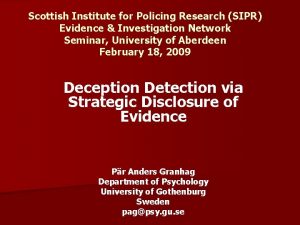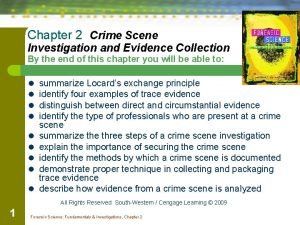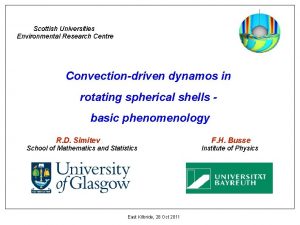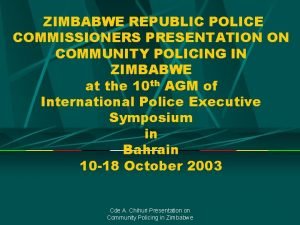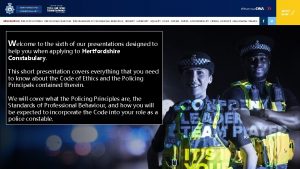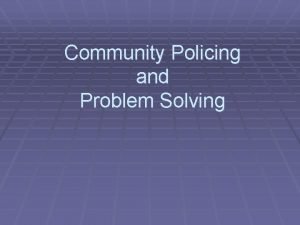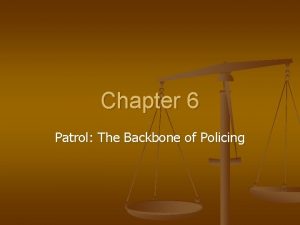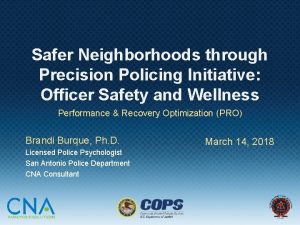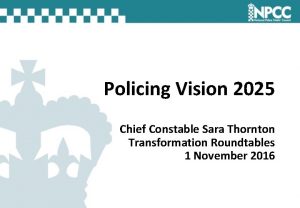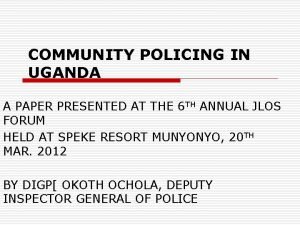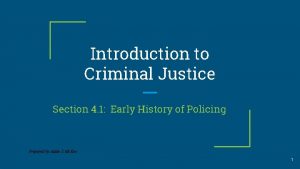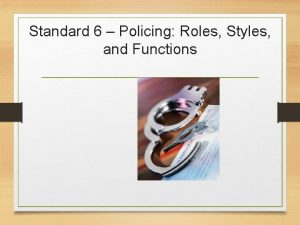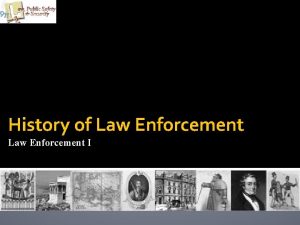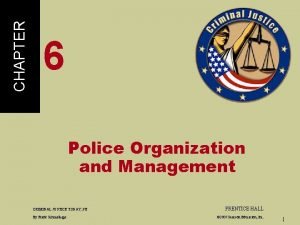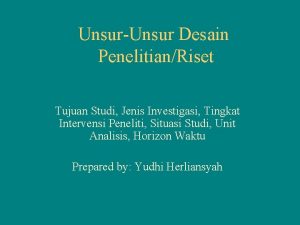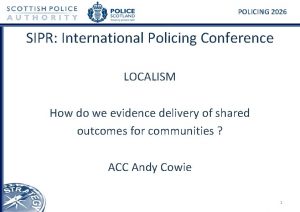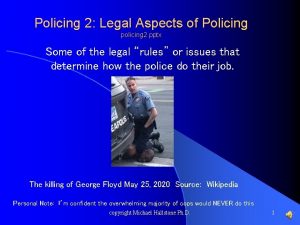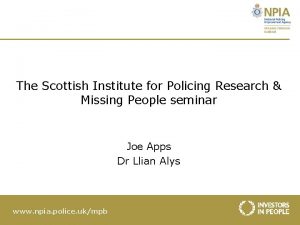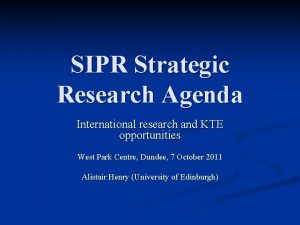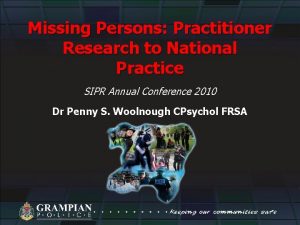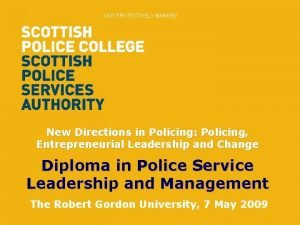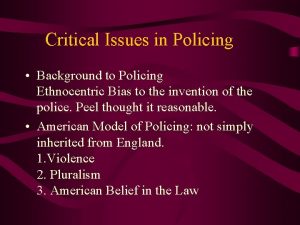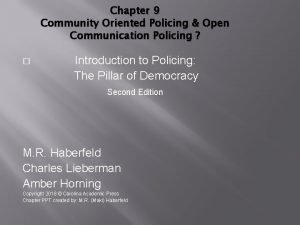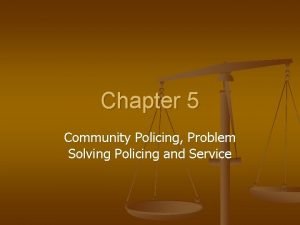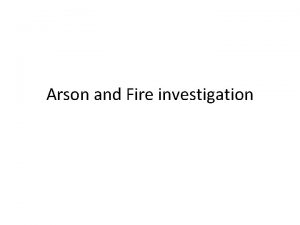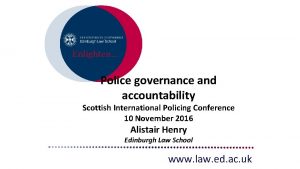Scottish Institute for Policing Research SIPR Evidence Investigation









































































- Slides: 73

Scottish Institute for Policing Research (SIPR) Evidence & Investigation Network Seminar, University of Aberdeen February 18, 2009 Deception Detection via Strategic Disclosure of Evidence Pär Anders Granhag Department of Psychology University of Gothenburg Sweden pag@psy. gu. se

Background (1) n To be able to correctly assess veracity is key in legal contexts n There are many views on how to best detect deception and truth n Research shows that people are not very good at this task (Vrij, 2008)

Background (2) n A person trying to detect deception can face one of two situations; (a) where there is no evidence speaking to the suspect’s guilt (very much research) (b) where there is some evidence (information) speaking to the guilt of the suspect (very little research)

Background (3) Traditional research on deception… - No background info - No interaction between interviewer and suspect (assess short video clips)

Points of departure n Previous research has neglected… …innocent and guilty suspects’ strategies …the information (evidence) speaking to the suspect’s guilt … how the use (misuse) of this information can affect deception detection accuracy

General aims n … a brief review of theoretical notions relevant for liars’ and truth-tellers’ strategies n … review empirical research on suspects’ counter-interrogation strategies n … show that knowledge about liars’ and truth-tellers’ strategies can be used to increase deception detection accuracy

Theoretical part – Aim: n Provide a theoretical framework resting upon psychological notions from three domains: 1. The psychology of instrumental mindreading 2. The psychology of self-regulation 3. The psychology of guilt and innocence

Mindreading: Background (1) * Edgar Allan Poe (1809 -1849), father of the modern detective story * Alter ego, Detective Auguste Dupin * The Purloined Letter * Story about a stolen letter, hidden by a clever Minister

Mindreading: Background (2) The Parisian Police searched the Minister’s house for months in order to find the letter, but without success. They looked for secret drawers, probed all cushions with fine long needles, examined legs in the furniture for cavities, and searched the grounds around the house.

Mindreading: Background (3) n Dupin (Poe) attributes the Parisian Police’s failure to: ”ill-admeasurement, or rather through non -admeasurement, of the intellect with which they are engaged. ” ”They consider only their own ideas of ingenuity and, in searching for something hidden, advert only to the modes in which they would have hidden the letter. ”

Mindreading: Background (4) n The police failed to mindread the Minister, whereas the Minister performed a mind reading of the police. n Hence, the Minister was able to predict the actions taken by the police in order to try to find the stolen letter, whereas the police failed to reconstruct the actions taken by the Minister in order to hide it

Mindreading: Background (5) n Poe draws our attention to why this case was so difficult to solve: (a) the police spent too much time thinking about their own strategies (b) their reasoning was biased by projection (false consensus) and stereotypical thinking

Mindreading: Definition (I) n The cornerstone of simulating the mind of another person (‘mindreading’) is that one imagines oneself being in the other person’s situation, which will trigger processes that are similar to those of the other (Malle & Hodge, 2005) We practice ‘mindreading’ on a daily basis “I can imagine how you must feel” “I guess you need a drink? ” n

Mindreading: Defintion (II) n The term ‘mindreading’ is used in an instrumental manner, to predict future behaviour. …not in a descriptive manner, trying to read the actual content of a person’s mind (“The number you are thinking of is four!”).

The goal of instrumental mindreading: To improve the ability to predict other people’s behaviour

Traps when reading minds (I) First, there are many reasons why interrogators may neglect the ‘mind of the suspect’. For example, a) too occupied thinking about their own tactics b) too eager to get a confession c) overconfident in their own ability to detect deception d) lack principles for strategically using the critical information at hand n

Traps when reading minds (II) n Second, interrogators may go wrong due to biases like… Projection (false consensus) = The interrogator assumes that the suspect has the same mental states as he/she would have had (being in the same situation), “If someone would present all this evidence, I would surely confess” Stereotyping = The interrogator assumes that the suspect has mental states that correspond to ‘the typical criminal’ “I know this type of…- I will break him by…”

Mindreading: Why? n If the interrogator is successful in reading the mind of the suspect, then he or she can … a) …more accurately predict the suspect’s behaviour b) …use these predictions to better plan and conduct the interrogation

Mindreading: How? Our mindreading ability can be improved if utilizing psychological theory on fundamental human behaviour and reasoning • • The psychology of self-regulation

The Psychology of Self-regulation (I) n Self-regulation refers to ways in which people n Self-regulatory strategies are particularly primed by threatening situations n A person anticipating a threat will have a number of self-regulative methods to choose from n The common objective of these methods is to try to restore control their behaviour (e. g. , Fiske & Taylor, 2008)

The Psychology of Self-regulation (II) n Decision control; refers to the sense of control achieved when making a decision with respect to how to engage in a forthcoming aversive event n Translated to crime suspects; decision control aims at reducing threat by deciding on how to act duríng the upcoming interview (counter-interrogation strategies)

The Psychology of Self-regulation (III) n Both guilty and innocent suspects will view a upcoming interrogation as a threat; this threat will evoke self-regulative strategies n Both guilty and innocent suspects want to change the interviewer’s attitude from suspicious to non-suspicious

Theoretical framework 1. The psychology of instrumental mind-reading 2. The psychology of self-regulation 3. The psychology of guilt and innocence

The psychology of guilt (I) n Guilty suspects often hold exclusive knowledge about the crime; this knowledge can – of course be incriminating n This self-incriminating knowledge can be construed as a threat (an aversive stimulus) n In brief, the threat for a guilty suspect is that the interviewer may come to know what he knows

The psychology of guilt (II) Guilty suspects’ decision control: n Have to decide upon what to admit, avoid and deny n One basic counter-interrogation strategy; it makes little sense to avoid or deny what the suspect believe the interviewer to already know

The psychology of guilt (III) n Decision control is particularly critical with respect to the incriminating information which the suspect is uncertain whether or not the interviewer holds Basically, two strategies: Avoidance (not to mention, e. g. visiting a certain place at a certain time) Denial (denying, e. g. being at a certain place at a certain time) n

The psychology of innocence (I) n Innocent suspects’ decision control is coloured by… A belief in a just world; people will get what they deserve, and deserve what they get (Lerner, 1980) The illusion of transparency; their inner feelings/ mental states will manifest themselves on the outside (Savitsky & Gilovich, 2003)

The psychology of innocence (II) n Many innocent suspects will decide to ‘tell it like it was’, and trust that ‘their innocence will shine through’ (Kassin, 2005) n Innocent (mock) suspects found to be more likely to waive their rights to silence, and cooperate during investigations (Kassin, 2005)

The psychology of guilt and innocence (I) n Guilty and innocent suspects have the same goal; to be perceived as innocent n They may use the same major selfregulatory method to reach this goal; decision control

The psychology of guilt and innocence (II) n Guilty suspects’ decision control is assumed to be influenced by aversion, which will result in avoidant strategies n Innocent suspects’ decision control is assumed to be influenced by the belief in a just world and/or the illusion of transparency, which will result in much less avoidant strategies

Empirical part: Briefly review research on guilty and innocent suspects’ counter-interrogation strategies

Guilty suspects’ counter-interrogation strategies (I) n Empirical work show that… … a majority of guilty mock-suspects report to have a strategy when facing a police interview …guilty mock-suspects tend to put their strategies to work during the interrogation

Guilty suspects’ counter-interrogation strategies (II) … guilty mock-suspects, if given the opportunity, tend to avoid mentioning the critical information … guilty mock-suspects, if deprived of avoidance as a way out, tend to deny that they hold incriminating knowledge.

Guilty suspects’ counter-interrogation strategies (III) n New empirical study on how… (a) interrogators’ degree of suspicion and (b) suspects’ past criminal record …affect guilty mock-suspects’ disclosure of crime-relevant information (Granhag, Clemens & Strömwall, 2009)

Guilty suspects’ counter-interrogation strategies (IV) n Participants: n Ex-criminals 45 students 45 ex-criminals recruited via a widespread national organization (KRIS), helping ex-criminals finding their way back to a non-criminal life

Guilty suspects’ counter-interrogation strategies (V) n None of the students reported to have been interviewed by the police n All ex-criminals had been interviewed by the police, and all of them reported to have lied in police interviews

Guilty suspects’ counter-interrogation strategies (VI) Procedure: n All mock-suspects had to imagine that they had stolen money from a store in a shopping center, and that they now faced a police interview (only guilty suspects) n Half of the ex-criminals and half of the students were told that they were under a high degree of suspicion (vs. low)

Guilty suspects’ counter-interrogation strategies (Vii) Procedure: n All mock-suspects were asked about their counter-interrogation strategies n Specifically, what to disclose in the ’free recall phase’ of the interrogation, and what to disclose in response to more directed/specific questions

Guilty suspects’ counter-interrogation strategies (Vii)

Guilty suspects’ counter-interrogation strategies (8) n Students disclosed significantly more (incriminating) information than did the ex-criminals n Under high (vs. low) level of suspicion students disclosed more information, whereas ex-criminals disclosed less information

Guilty suspects’ counter-interrogation strategies (8) n Under a high degree of suspicion naive (vs. experienced) mock-suspects seem to look differently upon the ’burden of proof’: - Naive mock-suspects take on the burden, and are more willing to talk (co-operate) - Experienced mock-suspects hand over the burden to the police, and are less willing to talk (co-operate)

Guilty suspects’ counter-interrogation strategies (9) n What can we learn from these results? 1) Raise some doubt with respect to using students as mock-suspects for certain deception experiments 2) Implications for strategic disclosure of evidence

Innocent suspects’ counter-interrogation strategies (1) n… significantly fewer innocent (than guilty) mock-suspects report to bring a strategy into the interview room n… very few innocent mock-suspects tend to avoid mentioning or deny holding the potentially incriminating information

Innocent suspects’ counter-interrogation strategies (2) … the principal ‘strategy’ among innocent suspects seems to be to ‘to keep the story real’ and ‘to tell the truth like it happened’ (Hartwig et al, 2007). … innocent (vs. guilty) suspects are more prone to waive their constitutional rights to silence and agree to be interrogated. Based on that they have nothing to hide, and that they believe that the truth will come out (Kassin & Norwick, 2004)

Suspects’ counter-interrogation strategies: Summing up n Suspects’ counter-interrogation strategies are moderated by a number of different factors, such as… - Mind-set (guilty vs. innocent) Background (criminal vs. non-criminal) Level of suspicion (high vs. low) Interview technique (confrontational vs. strategic) Type of crime (deny act vs. deny intent) -

From empirical work to interview tactics (I) The combined empirical evidence support the basic assumptions that. . (a) a suspect’s strategy is a reflection of his or her mental state n (b) a suspect’s behaviour is a reflection of his or her strategy

From empirical work to interview tactics (II) n We know that many guilty suspects avoid and/or deny holding potentially incriminating information; and that innocent suspects tend to believe that the ‘truth will shine through’. n But how do these findings translate into an interview technique (tactic)?

Investigators’ interrogation strategies (1) n What do we know about how professional investigators disclose the evidence (critical information) when interrogating suspects?

Investigators’ interrogation strategies (2) n Sources of information: - Recommendations from interview/interrogation manuals - Studies using real-life material - Experimental research

Investigators’ interrogation strategies (3) n Interrogation manuals are either silent on how to use the available evidence (e. g. Gordon & Fleisher, 2002), or recommend that the interrogation is started by confronting the suspect with the evidence (e. g. Inbau et al. , 2001; Yeschke, 1997)

Investigators’ interrogation strategies (4) n Analyses of real-life interrogations: - Disclosure of evidence (together with a suggestion of guilt) was the typical way to start the interrogation, occured in more than 80% of the cases (Leo, 1996) - British study found that on a minority (12%) of the cases the evidence was disclosed at the beginning of the interrogation (Moston & Engelberg, 1993)

Investigators’ interrogation strategies (5) n Quasi-experimental research… shows that experienced Swedish police officers do not seem to handle the available evidence very strategically when conducting an interrogation based on a brief casefile (Hartwig and colleagues, 2004)

Investigators’ interrogation strategies (6) n New study on Swedish customs officers (Granhag et al, 2009) n 80 customs officers; - 40 investigative unit - 40 crime fighting unit (on the field) Experienced professionals: Invest; M = 20, Crime fight; M = 25

Investigators’ interrogation strategies (7) n All participants worked through a detailed case file, and planned an interrogation with a suspect n Asked about their planning and how they intended to use the pieces evidence that they had identified as the most important

Investigators’ interrogation strategies (8) n Customs-study; Preliminary results Investigators (n=40): identified 205 pieces of critical information; 69 pieces (34%) immediately disclosed to the suspect 46 pieces (22%) used in a ’strategic’ manner

Investigators’ interrogation strategies (9) n Customs-study; Preliminary results Crime fighting unit (n=40): identified 182 pieces of critical information; 96 pieces (53%) immediately disclosed to the suspect 11 pieces (6%) used in a ’strategic’ manner

From empirical work to interview tactics (III) n We have outlined and tested the socalled The Strategic Use of Evidence technique (the SUE-technique) n The SUE-technique is very much a project under development

The SUE-technique: Some basic steps (I) n 1. Planning of the interview Carefully work through the case file and identify pieces of potentially incriminating information; especially information that the suspect will not know for certain that the investigator holds. Identify a) alternative explanations to this information and b) questions addressing this critical information. n 2. Informing the suspect In accordance with the relevant Codes of Practice; important that the investigator does not disclose any of the potentially incriminating information to the suspect. n 3. The free recall phase The investigator should encourage the suspect to ‘tell his or her story’

The SUE-technique: Some basic steps (II) n 4. Questions pertaining to alternative explanations Ask questions aimed at ruling out alternative explanations to the evidence n 5. Questions ‘addressing’ the evidence Questions addressing the potentially incriminating information; these questions should not reveal what the investigator knows. n 6. Securing the suspect’s statement The investigator must make sure that he has understood the suspect correctly; repeating the suspect’s statement, having the suspect correct any misunderstandings etc

The SUE technique: A training study (I) n Police Academy in Sweden n Phase 1: Interrogators (N = 82, police trainees): Half received training in the SUE technique (theoretical understanding, videomaterial, hands-on training) Half received no training

The SUE technique: A training study (II) n Phase 2: Each interrogator interviewed one mocksuspect (half of the suspects were guilty to a theft, half were innocent). Trained and untrained interrogators had the exact same case-file to use for planning the interrogation (the case file contained evidence against the suspect)

The SUE technique: A training study (III) The Result: The trained group interrogated in line with the SUE technique. That is, they… n n Did not disclose the evidence early Did ask for a free recall Did ask specific questions addressing the evidence, without disclosing the evidence Confronted guilty (but not innocent) suspects with the evidence, at the end of the interrogation

The SUE technique: A training study (IV) The Result: Differences between guilty and innocent suspects… n Guilty suspects avoided to mention ‘selfincriminating information’ during the free recall (innocent suspects did not) n Guilty suspects denied holding ‘self-incriminating information’ when asked specific questions (innocent suspects did not)

The SUE technique: A training study (V) Consequence: n Guilty suspects interrogated by trained interrogators showed higher statement-evidence inconsistency, than did guilty suspects interrogated by untrained interrogators

The SUE technique: A training study (VI) The Results: n Trained interrogators relied more on suspects’ verbal behaviour when assessing veracity, than did untrained interrogators n Untrained interrogators ‘burned’ the evidence early on, and then had to resort to non-verbal cues (non-diagnostic) in order to decide upon veracity

The SUE technique: A training study (VII) Deception detection accuracy: n Trained interrogators: 85. 4 % n Untrained interrogators: 56. 1 %

Limitations (I) n Obviously, the SUE-technique leaves no guarantee that a particular assessment of veracity will be correct n It is a technique under development n SUE-technique is not just about withholding the evidence n It is a systematic approach with respect to the alternative explanations that the (guilty) suspect might offer with respect to the evidence

Limitations (II) n Several possible limitations of the SUEtechnique must be addressed… 1) innocent suspects might show ‘statement-evidence inconsistency’ due to memory factors, or decide that the best way out is not to tell the truth 2) how the effectiveness of the technique is affected by the complexity of the case material, and a ’step-by-step’ disclosure

Limitations (III) n Issue raised: guilty suspects might decide to stay very close to the truth, and therefore show a high degree of ‘statement-evidence consistency’ n Data on ex-criminals’ strategies argue against this critique (they stayed far away from the truth)

Conclusions (I) n The SUE-technique is potent because it draws on the fact that guilty and innocent suspects… (a) entertain different mental states, and therefore … (b) resort to different strategies, and therefore … (c) respond differently with respect to the potentially incriminating information

Conclusions (II) n Obvious that one should use the SUEtechnique (or something similar) when interviewing suspects? n “Do you interview suspects in a strategic manner? ”

Conclusions (III) - The untrained police trainees did not use the SUE-technique (or something similar) - Experienced police and customs officers do not seem to use the SUE technique on a regular basis - Interrogation manuals recommend confrontation in order to ‘win the war’.

Poe & The purloined letter… n …as the Minister knew that the police would search his home for the stolen letter, he decided not to hide it. He simply nailed it to a board on the wall, holding some other papers. The letter was fully visible – but not easily found by those searching for something hidden.
 Scottish institute for policing research
Scottish institute for policing research Locard exchange principle
Locard exchange principle Scottish universities environmental research centre
Scottish universities environmental research centre Community policing in zimbabwe
Community policing in zimbabwe 9 policing principles code of ethics
9 policing principles code of ethics Digital policing portfolio
Digital policing portfolio Introduction of community policing
Introduction of community policing Community policing
Community policing Backbone of policing
Backbone of policing Traditional policing meaning
Traditional policing meaning Snppi
Snppi Police vision 2025
Police vision 2025 Community policing in uganda
Community policing in uganda Community governance definition
Community governance definition Chapter 5 policing history and structure
Chapter 5 policing history and structure Kin policing
Kin policing Backbone of police department
Backbone of police department Policing styles
Policing styles Peel's 12 principles of policing
Peel's 12 principles of policing The watchman style of policing emphasizes
The watchman style of policing emphasizes Vce chemistry practical investigation ideas
Vce chemistry practical investigation ideas Jenis investigasi
Jenis investigasi Qualitative research is holistic
Qualitative research is holistic Secondary sources
Secondary sources Primary evidence vs secondary evidence
Primary evidence vs secondary evidence Secondary sources
Secondary sources Primary evidence vs secondary evidence
Primary evidence vs secondary evidence Primary evidence vs secondary evidence
Primary evidence vs secondary evidence Fiber evidence can have probative value
Fiber evidence can have probative value Class evidence vs individual evidence
Class evidence vs individual evidence How can class evidence be useful
How can class evidence be useful Class vs individual evidence
Class vs individual evidence The absence of evidence is not evidence of absence meaning
The absence of evidence is not evidence of absence meaning Iso 22301 utbildning
Iso 22301 utbildning Typiska novell drag
Typiska novell drag Nationell inriktning för artificiell intelligens
Nationell inriktning för artificiell intelligens Returpilarna
Returpilarna Varför kallas perioden 1918-1939 för mellankrigstiden
Varför kallas perioden 1918-1939 för mellankrigstiden En lathund för arbete med kontinuitetshantering
En lathund för arbete med kontinuitetshantering Särskild löneskatt för pensionskostnader
Särskild löneskatt för pensionskostnader Personlig tidbok
Personlig tidbok Anatomi organ reproduksi
Anatomi organ reproduksi Densitet vatten
Densitet vatten Datorkunskap för nybörjare
Datorkunskap för nybörjare Stig kerman
Stig kerman Debattinlägg mall
Debattinlägg mall För och nackdelar med firo
För och nackdelar med firo Nyckelkompetenser för livslångt lärande
Nyckelkompetenser för livslångt lärande Påbyggnader för flakfordon
Påbyggnader för flakfordon Arkimedes princip formel
Arkimedes princip formel Publik sektor
Publik sektor Kyssande vind
Kyssande vind Presentera för publik crossboss
Presentera för publik crossboss Teckenspråk minoritetsspråk argument
Teckenspråk minoritetsspråk argument Kanaans land
Kanaans land Klassificeringsstruktur för kommunala verksamheter
Klassificeringsstruktur för kommunala verksamheter Fimbrietratt
Fimbrietratt Bästa kameran för astrofoto
Bästa kameran för astrofoto Cks
Cks Lågenergihus nyproduktion
Lågenergihus nyproduktion Mat för unga idrottare
Mat för unga idrottare Verktyg för automatisering av utbetalningar
Verktyg för automatisering av utbetalningar Rutin för avvikelsehantering
Rutin för avvikelsehantering Smärtskolan kunskap för livet
Smärtskolan kunskap för livet Ministerstyre för och nackdelar
Ministerstyre för och nackdelar Tack för att ni har lyssnat
Tack för att ni har lyssnat Vad är referatmarkeringar
Vad är referatmarkeringar Redogör för vad psykologi är
Redogör för vad psykologi är Borstål, egenskaper
Borstål, egenskaper Tack för att ni har lyssnat
Tack för att ni har lyssnat Borra hål för knoppar
Borra hål för knoppar Orubbliga rättigheter
Orubbliga rättigheter Hur räknar man standardavvikelse
Hur räknar man standardavvikelse Tack för att ni har lyssnat
Tack för att ni har lyssnat
